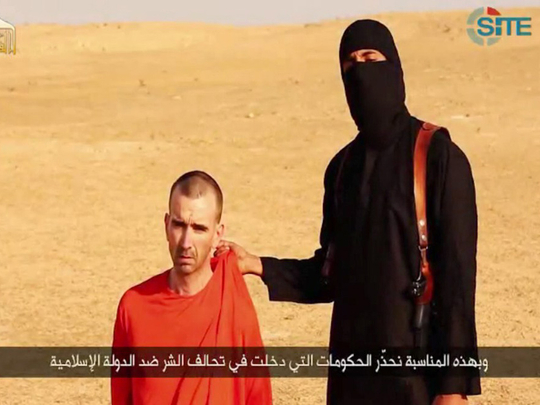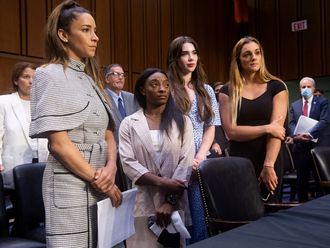
Dubai: Islamic State of Iraq and the Levant (Isil) extremists have released a video showing the beheading of a second American journalist, Steven Sotloff, and warned President Barack Obama that continuing airstrikes against the group in Iraq will be met with the killing of more Western captives.
The footage — depicting what the US called a sickening act of brutality — was posted late on Tuesday, two weeks after the release of a video showing the killing of journalist James Foley and just days after Sotloff’s mother pleaded for his life.
Barak Barfi, a spokesperson for the family, said the Sotloffs had seen the video but that authorities have not established its authenticity. “The family knows of this horrific tragedy and is grieving privately. There will be no public comment from the family during this difficult time,” Barfi said.
Sotloff, a 31-year-old Miami-area native who freelanced for Time and Foreign Policy magazines, vanished in Syria in August 2013 and was not seen again until he appeared in a video released last month that showed Foley’s beheading. Dressed in an orange jumpsuit against an arid Syrian landscape, Sotloff was threatened in that video with death unless the US stopped airstrikes on Isil.
In the video, the militant group threatens to kill another hostage identified as a British citizen.
Britain and France called Sotloff’s killing “barbaric.”
The UK government will examine “every possible option” to protect the British hostage threatened with death by the Isil, foreign secretary Philip Hammond said. His comments came as he confirmed that an unsuccessful attempt was made to rescue the British hostage and others held by Isil.
British government sources said Prime Minister David Cameron had known of the threat to the man’s life for many months and so it would not change his short-term calculations, but the revelation of the threat to the public in the gruesome Isil video is likely to put more pressure on the UK to join the air strikes that the Americans have been conducting for weeks against Isil in northern Iraq.
It is thought the reference to the rescue bid referred to an unsuccessful operation by American commandos in July, when they raided an oil refinery near the Syrian city of Raqqa, but did not find the hostages they had believed were being held there.
Hammond refused to rule out air strikes: “It doesn’t make any difference at all to our strategic planning. If we judge that air strikes could be beneficial, then we will certainly consider them. But we have made no decision to do so at the moment.”
Cameron has already told MPs he regards Isil as a threat to the British way of life, and has not ruled out RAF involvement in air strikes.
Cameron is certain to confer with the US president Barack Obama at the Nato summit in Wales on Thursday about the threat to further hostages and the wider strategy to combat Isil.
Obama is under intense domestic pressure to be more decisive and is considering whether to extend the air strikes to Syria, the original base of Isil.
Cameron, at the G8 and G20, has led the calls on governments not to pay ransoms to hostages, and he is unlikely to change that policy in this case.
US State Department spokesperson Jen Psaki said on Tuesday that “a few” Americans are believed to be held by the Isil. Psaki would not give any specifics, but one is a 26-year-old woman kidnapped while doing humanitarian aid work in Syria, according to a family representative who asked that the hostage not be identified out of fear for her safety.
The fighter who apparently beheads Sotloff in the video calls it retribution for continued US airstrikes against the group.
As the Isil has moved to expand its proto-state over the past year, it has frequently published graphic photos and gruesome videos of bombings, beheadings and mass killings.
Last week, Sotloff’s mother, Shirley Sotloff, pleaded with his captors for mercy, saying in a video that her son was “an innocent journalist” and “an honourable man” who “has always tried to help the weak.”
As a student at Kimball, Sotloff “developed a passion for reporting and writing, a gift that he shared with people around the world, and this unthinkable act of terror has taken him from us far too soon,” New Hampshire Governor Maggie Hassan said in a statement.
Sotloff attended the University of Central Florida, which said he majored in journalism from 2002 to 2004 but apparently left without graduating.
Just how Sotloff made his way from Florida to Middle East hotspots is not clear. He published articles from Syria, Egypt and Libya in a variety of publications. Several of those articles focus on the plight of ordinary people in war-torn places.
In a statement, Foreign Policy magazine called him a “brave and talented journalist” whose reporting “showed a deep concern for the civilians caught in the middle of a brutal war.”
Time Editor Nancy Gibbs said Sotloff “gave his life so readers would have access to information from some of the most dangerous places in the world.”












